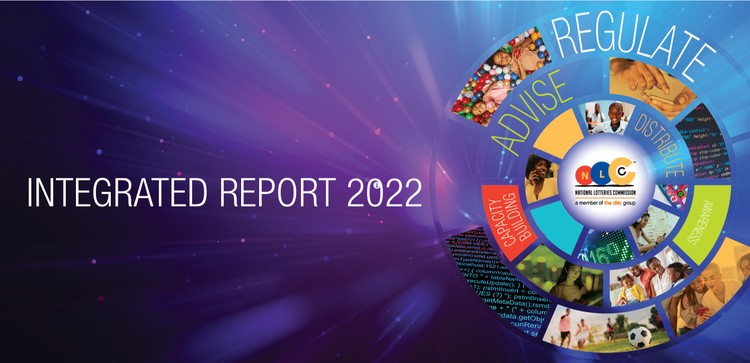Row over cost of Lottery’s annual reports
An answer in Parliament reveals millions of rand were spent on the reports over three years. But the company that produced them has defended its work and called on the DA to correct a condemnatory statement.
Front cover of the National Lottery Commission’s 2022 annual report.
- The National Lotteries Commission spent R7.3 million on its annual reports over the past three years.
- This is according to a written answer by Minister Ebrahim Patel to a question asked in Parliament.
- A row has erupted after the DA condemned the printing of only 475 copies, which works out to an average of over R15,000 per copy.
- But Ince the company that produced the reports, has shot back, pointing out that it did the content and design of the reports, both for online and print.
The National Lotteries Commission (NLC) spent almost R7.3-million over three years on its annual reports.
The NLC paid R2.6-million and printed 70 copies of the report in 2022. In 2021, it paid R2.69-million and printed 200 copies. In 2020 it paid R1.98-million and printed 205 copies. But the reports are also online.
All the reports over the three-year period were produced and printed by Ince (Pty) Ltd. The project was handled by the office of the company secretary Nompumelelo Nene, who is currently on suspension pending a disciplinary inquiry.
The details of the prices paid for the reports were revealed by Minister of Trade and Industry Ebrahim Patel in an answer to a written parliamentary question posed by Democratic Alliance MP Dean Macpherson. The wording of Patel’s response implied that the cost was only for printing but according to Ince the cost included much more, including the content and design of the reports.
The cost of the annual reports is one of the many procurement issues that has led the Special Investigating Unit (SIU), which has been investigating NLC corruption since 2020, to apply for its mandate to be extended to include procurement.
The SIU has come across several instances of potential fraud and corruption involving procurement. The Auditor-General (AG) also highlighted problems with procurement, and the NLC itself has received several tip-offs about questionable procurement, which are being investigated internally and by three audit firms.
But until its mandate is extended, the SIU’s hands are tied, as the 2020 proclamation signed by President Cyril Ramaphosa only allows it to investigate corruption involving grants.
In his response to Parliament, Patel said: “Given the amounts of money involved in the printing of the annual report, this expenditure should also be covered by the internal and external investigation.”
The official with “relevant information on the distribution of the copies of the Annual Report” is currently on suspension and therefore not all the requested information is available, Patel said. “I have further requested the NLC to provide an updated report on the distribution of annual reports as soon as the information is available.”
The wording of the answer suggests that the money was spent entirely on printing, which led to Macpherson stating: “This ridiculous spending works out to R37,000 per [2022] annual report or R255 a page. This sort of grand scale corruption has come to define the NLC in recent years, which was vigorously defended by the ANC in Parliament.”
He said that the DA had sourced costing from a local company and “found that this should not have cost more than R200 per booklet. The question is, how was a company allowed to rip off the NLC, inflate costs by 18,500% without any questions being asked and for so long?”
But Ince’s CEO Peter Backwell took issue with the DA’s statement and has asked Macpherson to correct “misleading and inaccurate statements”.
In a letter to GroundUp, Backwell wrote that the cost includes “Strategic and editorial advisory”, “Research, interviews, content development , copywriting, review and structural editing”, “Design, production and publishing”, and “Digital campaigns”.
Backwell stated: “Most organisations in the digital era have a very small print run for their annual reports – if they print hard copies at all. A small print run (of, say, 70 copies) would make up a small fraction of the total project cost, as most of the work that Ince does is digitally based and the output is in the form of HTML (website) interactive reports, PDF documents, other electronic formats (such as XBRL) and a very small volume of printed reports. Most reporting entities have
little requirement for printed copies as the electronic copies are shared with stakeholders. Dividing the cost of an annual report project by the number of printed copies is misleading.”
Support independent journalism
Donate using Payfast

Don't miss out on the latest news
We respect your privacy, and promise we won't spam you.
Next: Illegal connections to blame for leaving learners in the dark, says Eskom
Previous: Diepsloot residents say police and municipality have left them to the mercy of criminals
© 2023 GroundUp. This article is licensed under a Creative Commons Attribution-NoDerivatives 4.0 International License.
You may republish this article, so long as you credit the authors and GroundUp, and do not change the text. Please include a link back to the original article.
We put an invisible pixel in the article so that we can count traffic to republishers. All analytics tools are solely on our servers. We do not give our logs to any third party. Logs are deleted after two weeks. We do not use any IP address identifying information except to count regional traffic. We are solely interested in counting hits, not tracking users. If you republish, please do not delete the invisible pixel.

